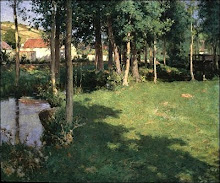His simple palette consisted of the primary colors: three blues, three yellows and three reds.
Permalba white
Ultramarine blue
Cobalt blue
Winsor blue
Cadmium yellow pale
Cadmium yellow deep
Yellow ochre
Alizarin crimson
Cadmium scarlet
Indian red
Burnt umber, cadmium pale green for highlighting leaves, and cadmium lemon were also used with less frequency.
He primed his supports with brilliant white oil paint that lent a brilliance to the colors layed over it. He used the Impressionist technique of optical mixing of colors but was careful to make them of the same tonal value. Wilson describes his method for painting a vibrant sky.
Set out three dabs of white (or four, if you want to use two blues). With one mix a tint of ruby madder, with one a tint of cadmium, and with the remaining one (or two) tints of blue. In working the color into the white, you can produce a graduated tint, covering the range of values you will want in your sky. Then from the deepest part of the tints you can mix a color for the top of the sky. As you come down, use successively lighter parts of the tints. An effective way of mixing the color from the three tints is not to use a knife, but to pick up a bit of each tint directly with your brush. Stir them together only lightly, so that they are not too thoroughly mixed. Then you will get a suggestion of broken color, in a free, loose way. In preparing the three (or four) tints, be careful to make the values correspond; for in broken color it is important to have your values the same; otherwise the colors will never flow together and produce vibration. This, to my mind, is the failing of the French Impressionist painter Seurat. He uses dots of color of varying values and they remain just dots of color, never uniting to the eye as Monet's do.
Source: www.peabody.yale.edu



.jpg)













+1900.bmp)
No comments:
Post a Comment